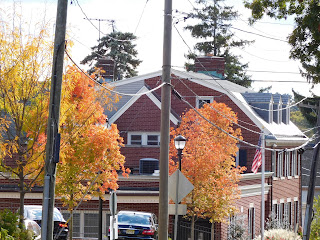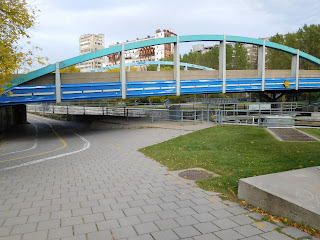The weather warmed up a bit today, but it was still pretty blustery. Still, this day felt very October-like, in contrast to the last three days, which felt more like Thanksgiving weekend. Not that I mind cool or chilly weather; it just seemed to follow me from Canada after the mild weather this part of the world was experiencing as I embarked.
Anyway, this afternoon I had some time to sneak out for a Coney Island ride, and to return home via the path that passes under the Verrazano-Narrows Bridge--about 65 kilometers all told.
One sign that it's really Fall is that the boardwalk was not full of the strollers, sunbathers and such one sees even on weekdays for a few weeks after Labor Day. But, more important, the light and air take on different hues and feels around the time of the Equinox.
Is it my imagination, but has the Parachute Jump taken on the color of fallen leaves? A few weeks ago, it seemed more like a reddish-orange. Hmm...Could I be imposing my ideas of the season on things I see? Is life imitating the season?
Whatever, Tosca seemed to be enjoying it as much as I did. Even though I didn't have a lower gear to shift into when I was pedaling into the wind, I didn't feel as if I had been straining. In fact, riding today seemed like a shorter version of my ride the other day, albeit with different scenery. Maybe it has something to do with the way I respond to the light and air of this time of year.
On the Coney Island Boardwalk, this sign has a way of popping up where you've never seen it before, after you haven't seen it for a long time.
I would have expected to see it during the height of the summer season. As a matter of fact, a couple of times when I rode on the boardwalk during the summer, police officers motioned for me to get off my bike. But today there were no cops in sight.
Still, I didn't ride along the boarwalk: I had just a bit more than enough time to ride to Coney and back. But it was plenty.
Anyway, this afternoon I had some time to sneak out for a Coney Island ride, and to return home via the path that passes under the Verrazano-Narrows Bridge--about 65 kilometers all told.
One sign that it's really Fall is that the boardwalk was not full of the strollers, sunbathers and such one sees even on weekdays for a few weeks after Labor Day. But, more important, the light and air take on different hues and feels around the time of the Equinox.
Is it my imagination, but has the Parachute Jump taken on the color of fallen leaves? A few weeks ago, it seemed more like a reddish-orange. Hmm...Could I be imposing my ideas of the season on things I see? Is life imitating the season?
Whatever, Tosca seemed to be enjoying it as much as I did. Even though I didn't have a lower gear to shift into when I was pedaling into the wind, I didn't feel as if I had been straining. In fact, riding today seemed like a shorter version of my ride the other day, albeit with different scenery. Maybe it has something to do with the way I respond to the light and air of this time of year.
On the Coney Island Boardwalk, this sign has a way of popping up where you've never seen it before, after you haven't seen it for a long time.
I would have expected to see it during the height of the summer season. As a matter of fact, a couple of times when I rode on the boardwalk during the summer, police officers motioned for me to get off my bike. But today there were no cops in sight.
Still, I didn't ride along the boarwalk: I had just a bit more than enough time to ride to Coney and back. But it was plenty.









































